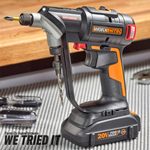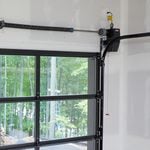8 Simple Garage Door Maintenance Tips

Eight simple to-dos to prolong your garage door's life and keep it running smoothly.
Our editors and experts handpick every product we feature. We may earn a commission from your purchases.
Quick: What’s the largest moving object in the typical home? If you guessed a garage door, go to the head of the class.
“It gets heavy use, has a lot of moving parts and can be expensive to replace,” says Randy Swigert of Tri City Garage Doors in Greeley, Colorado. “Depending on your market, a basic 16- x 7-ft. non-insulated door with installation runs about $2,000, and an insulated door the same size is around $2,400.”
At those prices, it’s imperative to do everything you can to keep your garage door in tip-top shape. Here are eight simple things to properly maintain your garage door.
On This Page
Limit Use
Many homeowners with an attached garage enter and exit their home almost exclusively through the garage door. If that’s you, break that habit.
“Go through your house doors more often,” says Dave Krzyzak, of Palm Valley Garage Doors in Goodyear, Arizona. “I tell customers to use their house key, and some of them smile and say, ‘What’s a house key?’
“The garage door typically has five to 10 up-down cycles a day. At 10 cycles daily, you may have to replace the springs every 2-1/2 years. But if it’s two cycles a day, spring replacement may be every seven or eight years.”
Schedule Inspections
“People tend to overlook their garage door until there is a major problem that’s costly to fix,” says Krzyzak. “They don’t think twice about scheduling an oil change for their car, and they should do the same for their garage door.”
Perform an inspection twice a year to stay on top of issues with panels, hinges, pulleys, rollers, cables and springs. It’s also helpful to periodically book an inspection with a garage door specialist. It costs about $70 per door.
Clear Tracks and Tighten Hardware
Remove rust and debris from the tracks on both sides of the garage door. Check brackets holding the tracks to the wall and ceiling, plus fasteners securing the garage door opener unit. Door vibration can loosen hardware so use a socket wrench to tighten loose bolts.
“With garage doors, you shouldn’t touch anything that requires special tools,” says Krzyzak. “Also, I see customers who have fiddled with red nuts and bolts on garage doors. Some of them end up in a hospital because the red is a danger warning.”
Lubricate
Keep rollers and other moving parts lubricated, which reduces stress on rollers and the door opener. Twice a year, apply a spray lubricant on the rollers and hinges, then wipe off excess.
“Dust collects and builds up on parts, creating noise,” says Krzyzak. “The original version of WD-40 breaks down that gunk and prevents rust and corrosion. In my 20 years in the industry, I have found WD-40 works best.”
Test the Door Balance
Springs balance the door so it opens and closes smoothly. An unbalanced garage door makes the opener work harder, shortening its lifespan.
Here’s how to test balance: Close the garage door and pull the release handle, which disengages the automatic opener. Then manually lift the door until it’s about halfway open. “The door should not go up or down more than a foot, and then remain in place without help,” says Swigert.
If it creeps up or down, the door is not balanced or the springs are worn. To repair, call a professional.
Test the Auto Reverse
This safety feature forces the garage door to quickly reverse if it detects an obstacle, like a car, animal or child. It’s activated by a pressure sensor or photocells on each side of the door.
Test your auto reverse monthly by placing a 1-1/2-inch block on the floor under the door. The door should reverse within two seconds after striking the block. To test the photoelectric system sensors, which are mounted four to six inches above the floor on each side of the garage door frame, start your door downward and move your leg in the door’s path. The door should reverse and move up.
If the auto reverse fails, disconnect the door opener and call a pro to fix it. Older garage door openers without this basic feature — now mandated by building code in many areas — should be replaced.
Replace Weatherstripping
The rubber weatherstripping keeps out cold, water and debris. Sold at hardware and big-box home improvement stores, it has a flange that slides into a groove in the bottom of the garage door.
Weatherstripping for wood garage doors is usually nailed in place. If this bottom weatherstripping is torn, replace it. Reattach loose weatherstripping along the sides of the door, or replace it if badly worn or damaged.
Clean and Paint
Protect and preserve your garage door, which often takes a beating from the sun and the weather. Sand, prime and paint rust spots on steel garage doors. Wash fiberglass doors with an all-purpose cleaner. For wood doors subject to warping and water damage, remove chipped and peeling paint before sanding and painting.
“Here in Arizona’s sun and heat, you have to regularly treat garage doors,” says Krzyzak. “You may install a new high-end, $10,000 cedar overlay door, and within six months without treatment it can look like it’s 15 years old.”



